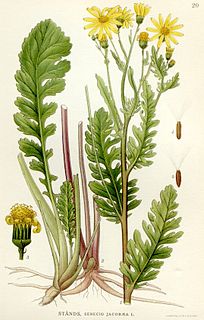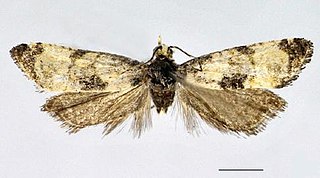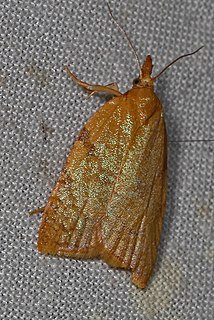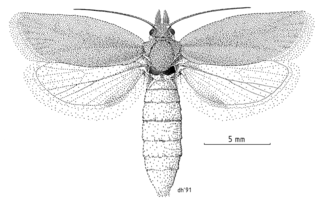
Senecio is a genus of the daisy family (Asteraceae) that includes ragworts and groundsels. The scientific Latin genus name, Senecio, means "old man."

Jacobaea vulgaris, syn. Senecio jacobaea, is a very common wild flower in the family Asteraceae that is native to northern Eurasia, usually in dry, open places, and has also been widely distributed as a weed elsewhere.

Senecio vulgaris, often known by the common names groundsel and old-man-in-the-spring, is a flowering plant in the daisy family Asteraceae. It is an annual herb, native to Europe and widely naturalised as a ruderal species in suitable disturbed habitats worldwide.

Senecioneae is the largest tribe of the Asteraceae, or the sunflower family, comprising about 150 genera and 3,000 species. Almost one-third of the species in this tribe are placed in the genus Senecio. Its members exhibit probably the widest possible range of form to be found in the entire plant kingdom, and include annuals, minute creeping alpines, perennial herbs, shrubs, climbers, succulents, trees, and semiaquatic plants.

Baccharis is a genus of perennials and shrubs in the aster family (Asteraceae). They are commonly known as baccharises but sometimes referred to as "brooms", because many members have small thin leaves resembling the true brooms. They are not at all related to these however, but belong to an entirely different lineage of eudicots. B. halimifolia is commonly known as "groundsel bush", however true groundsels are found in the genus Senecio.
Senecio cambrensis is a flowering plant of the family Asteraceae. It is endemic to Great Britain and currently known only from North Wales. It is a recently evolved plant that arose suddenly as a result of hybridization between two related species.

The wildlife of Namibia is composed of its flora and fauna. Namibia's endangered species include wild dog, black rhino, oribi and puku.

Delairea is a plant genus within the family Asteraceae that is native to South Africa. It is classified within tribe Senecioneae. It contains only one species, Delairea odorata, which was previously included in the genus Senecio as Senecio mikanioides, and is known as Cape ivy in some parts of the world and German ivy in others.

Senecio gallicus, an annual plant of the genus Senecio and family Asteraceae, is a species that colonizes isolated habitats with difficult environmental conditions. It is widespread across southern France and the Iberian Peninsula in deserts and xeric shrublands, on steppes and salty dry coastal plains. S. gallicus is playing a predominant role in shaping patterns of genetic structure by presenting models of historical associations among population rather than patterns of ongoing gene flow.

Senecio vernalis is one of the European species of Senecio, an annual that is also known as eastern groundsel. While it has been long classified as Senecio vernalis, this species has more recently been described as a subspecies of Senecio leucanthemifolius and is now included by some in that species.

Syndemis musculana is a moth of the family Tortricidae. It is found in Europe, China, the Korean Peninsula, Japan, Russia (Amur) and North America.
Platyptilia isodactylus is a moth of the family Pterophoridae found in China, Europe and was introduced to Australia for biological control. It was first described by the German entomologists, Philipp Christoph Zeller in 1852.

Stigmella ogygia is a moth of the family Nepticulidae. It is found in New Zealand.

Cochylichroa atricapitana, the black-headed conch, is a moth of the family Tortricidae. It is found in China (Xinjiang) and most of Europe.

Cochylis dubitana, the little conch, is a moth of the family Tortricidae. It is found in China (Heilongjiang) and most of Europe. It is also found in North America, where it has been recorded from Colorado, Maine, Ontario and Washington.

Sparganothis senecionana is a species of moth of the family Tortricidae. It is found in western North America, from British Columbia to Mexico and east to Colorado.

Cnephasia gueneeana is a moth of the family Tortricidae. It was described by Philogène Auguste Joseph Duponchel in 1836. In Europe, it has been recorded from Great Britain, France, Italy and Greece. The species is native to the Mediterranean sub-region, ranging from Palestine and southern Europe to Morocco and the Canary Islands.

Commophila aeneana, the orange conch, is a species of moth of the family Tortricidae. It is found in Great Britain, France, Belgium, Luxembourg, the Netherlands, Germany, Austria, Switzerland, Italy and Romania.

Ascerodes prochlora is a species of moth of the family Tortricidae. It is found in New Zealand.

Clepsis peritana, the garden tortrix or strawberry garden tortrix, is a species of moth of the family Tortricidae. It is found in Spain, Cuba, as well as North America, where it has been recorded from southern Canada throughout the United States.

















